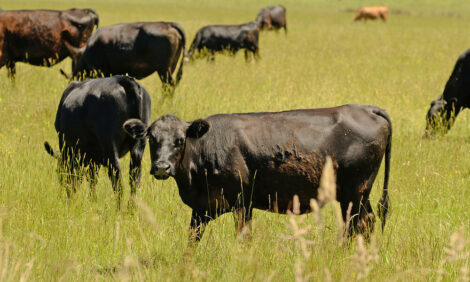



AHDB Plans to Boost UK Dairy Exports
UK - AHDB Dairy is focusing its attention on increasing export markets for British dairy produce. British Dairying asks Jean-Pierre Garnier, AHDB head of exports, what the campaign involves and what are its aspirations.Why is AHDB investing in the export market for dairy produce at this time?
There are two main reasons. Firstly, levy payers have expressed the view that the work of AHDB should not only aim to reduce costs of production but also to increase farm gate prices by targeted promotion on the home and export markets. And secondly, there has been a dearth of promotion of British dairy products for some time, which has hampered exports, whilst our competitors have invested constantly over the years to raise their image on world markets.

How much money is being committed to the campaign and over what time, and how does this compare with the AHDB Dairy budget for domestic promotion?
Budgets for 2017-20 have yet to set and agreed by the board of AHDB Dairy. Domestic promotion is generally more costly as it involves communication to the end consumer. Export promotion, in contrast, entails mainly trade development and the changing of perceptions in the longer term. However, I must stress that exports require critical mass to be effective.
Isn’t the AHDB Dairy export budget a drop in the ocean compared with commercial dairy company budgets?
The sums in question are indeed tiny when compared to the budgets of dairy companies spent on domestic marketing. However, as I have already said, expenditure in terms of trade development is more cost-effective than consumer marketing. In addition, the type of promotion is very different. Consumer marketing mainly consists of short-term campaigns whilst export promotion, to be effective, must take place consistently with medium- and long-term objectives.
How will the budget be spent?
There’s a three-pronged approach to the spending:
- Market knowledge, brand/image development and PR.
- Demonstrating the quality of British dairy products, mainly thorough tastings and information at trade, gastronomy and specialised dairy shows.
- Adding value to exports by working jointly with exporters through trade missions, trade development and promotional support with the retail and food service industries.
Can individual British on-farm processors directly benefit from the campaign?
Working jointly with small- and medium-size dairies is a fundamental tenet of the strategy and we will be visiting dairies up and down the country in order to understand their offer and export capability, and to involve them in our activities.
What potential is there for the campaign to impact on farm-gate prices for milk?
The aim of this effort is to create/increase demand for British dairy products. Through increased demand, we aim to raise production and eventually prices, but it will take time before tangible results can be achieved. However, we have now started on this road, which is the important point.
How supportive is the UK government of the AHDB Dairy campaign? What departments are involved and is there further financial backing?
The Great British Food Unit in Defra is in charge of export promotion and market access for British food and drink. Needless to say, we are working very closely with the unit and individual embassies but we do not receive external funding.
How much UK dairy produce is exported now (or at the outset) and what is the target for the campaign?
A great deal is already exported. We estimate that some €1.2 billion worth of dairy products will be exported from these shores in 2016. However, much more can and must be done. We are facing a widening dairy trade deficit and it is high time this is tackled. Britain has great potential as a dairy producer and exporter which needs to be fulfilled.
Aside from the current low value of the pound, how do you see Brexit affecting the UK’s access to export markets? Will they be easier or more difficult to penetrate?
Brexit is not affecting what we do. In practice, we are years away from the separation and we cannot wait and see, but must make progress with the programme, particularly as there is no clarity in the UK trade position in the long term. More importantly, the devaluation of sterling is providing a boost to exports. This has already been partly reflected in higher farm-gate prices and subsidies, and we expect export volumes to start increasing over the next few months.
What are the particular selling points of UK dairy produce?
There are many strong unique selling points for UK dairy and some favourable perceptions such as: sustainability, ‘green’ farming, high cattle welfare, a wealth of traditions, outstanding quality products, high level of product innovation, safety and more. This is a too-well-kept secret!
What are international perceptions of UK dairy produce?
Speaking to international buyers, most are unaware of the British offer – unlike those of our competitors. This is due to the lack of marketing and presence on international markets. The example of Switzerland is telling. Swiss cheeses are sold at high prices all over the world following many years of consistent marketing of the Swiss dairy brand. However, the perception of British dairy products is good in countries or territories with strong British links such as Hong Kong or Malta.
Where do you see the growth in terms of geographical regions?
We need to develop our exports outside the EU. This means particular attention to the North American/Caribbean region, the Middle East and Asia. The Far East is by far the most dynamic area of the planet. Did you know that by 2030, 66 per cent of the world’s middle class will live in the Asia-Pacific region? Whilst we must develop sales outside the EU, we cannot turn our back to the huge and wealthy European continent with major dairy-consuming countries such as France and Germany.
What is your product strategy?
We intend to initially concentrate on premium dairy products, for a number of good reasons:
- In terms of national image and perception, premium cheeses are the most important category and need immediate attention due to the lack of investment.
- Britain has a strong offering in this area which needs to be developed.
- The whole dairy category will benefit from what we describe in marketing terms as a ‘trickle down’ and ‘halo’ effect from exposure to the premium end.
- This approach will allow us not to over-extend ourselves and to keep a clear focus in the short term.
I understand you are also in charge of British meat exports. What can the dairy industry learn from your experience of the meat industry or gain from existing contacts?
We have invested in the promotion of British meat abroad since 1980 and, despite set-backs due to animal health issues, we have a quality image on the world markets and achieve enviable prices for exported lamb, beef, pork and allied products. We will use some guiding principles that have made meat exports a success. We also have a strong structure in place with a network of representatives on many markets, undertake activities yearly in 40 countries and benefit from internal AHDB resources such as market intelligence. This brings critical mass to our export push and, certainly, all the ingredients are in place to make it a success.
TheCattleSite News Desk



